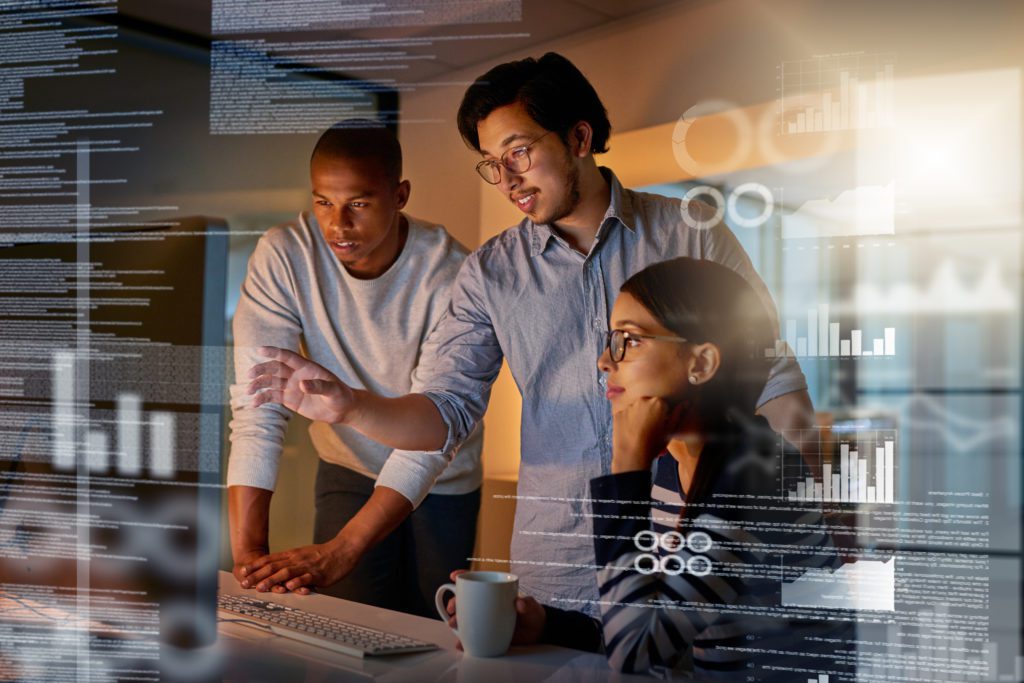Craig Resnick covers the PLC, PAC, HMI, OIT and Industrial PC markets as well as the Packaging, Plastics and Rubber Industries for ARC. He is the primary analyst for many of ARC’s Automation Supplier and Financial Service clients. Craig’s focus areas also include Production Management, OEE, HMI Software, Automation Platforms, and Embedded Systems. Craig has 30 years’ experience in sales, marketing, product development, and project management in the industrial market, gained with major suppliers of PLCs, process control systems, power transmission equipment, and field devices. Craig is a graduate of Northeastern University with an MBA and BS in Electrical Engineering.
This year’s “Key Technology Trends” report builds on many of the same trends ARC Advisory Group discussed in last year’s report. There’s a reason for this. End users today are demonstrating an improved grasp on how disruptive technologies and approaches can be implemented effectively in their operations and across their enterprises to gain business value. This is critical for any organization to not only survive, but to thrive long-term in a world where the only certainty is change.
In last year’s report, we discussed augmented reality for knowledge transfer, virtual reality for training and simulation, deployment of combined cloud/edge solutions, convergence of IT/OT cybersecurity, and digital twins. As discussed in this report, in addition to the above, for 2020, some of the new technologies and approaches we’re tracking include deploying the next generation of Industrial IoT edge solutions; the increasing use of cyber-physical systems; accelerating the development of open process automation systems and standards; digital transformation shifting focus from basic digitization to full digitalization; applying systems engineering practices to industrial cybersecurity; and others.
All of these trends are poised to either enter the mainstream or – if already there – to continue to gain acceptance. All relate to the overall digital transformation of industry, infrastructure, and today’s increasingly smart cities and municipalities. In no particular order, here are some of the key technologies that ARC Advisory Group believes will increase in importance over the next twelve months or so. While far from a complete list, the technologies discussed in this report will almost certainly make an impact on industry, infrastructure, and municipalities in 2020.
Deploying Industrial IoT Edge 2.0 Solutions
The edge of industrial internet-enabled architectures is becoming increasingly important. This is due largely to its often-critical role in determining the success of digital transformation strategies. Initially focused on delivering timely, clean data to cloud-based applications, the edge is emerging as an entirely new ecosystem within the overall enterprise architecture. Solution architects now rely on the edge not only for cloud integration, but also as a solution to address manufacturers’ concerns about latency, security, cost containment, and isolation for production environments.
Edge computing applications, particularly high-value analytics and artificial intelligence (AI) delivered via machine learning (ML), allow data to be processed near its source. The spike of investments targeted at this space helps demonstrate its increasing importance. IT and OT suppliers alike are introducing new Industrial IoT edge hardware, software, and solution offerings. ARC now refers to this as “Industrial IoT Edge 2.0.” It offers important improvements in ease-of-use, self-service, and turnkey operation; while emphasizing business outcomes and application-specific solutions versus pervasive infrastructure. Moving forward, Industrial IoT Edge 2.0 offerings will place greater emphasis on turnkey solutions that address specific outcome-oriented use cases. This represents a shift away from a simple “run the operations” mentality to use of real-time data analytics to rethink competitive fundamentals.
Increasing Use of Cyber-physical Systems
While manufacturers ramp up to meet demand for the growing “smart product” market, they face challenges developing and manufacturing new and more complex products and systems. These require tight integration between the computational (virtual) and the physical (continuous) worlds. To meet these complexity and integration requirements, more cyber-physical systems will be deployed using advanced simulation platforms that cover model-based mechatronic systems engineering, embedded system design integration, and simulation models that validate product and system design in the physical world.
Cyber-physical systems are an engineered system or mechanism controlled or monitored by computer-based algorithms and tightly integrated with both the internet and its users. In cyber-physical systems, physical and software components are deeply intertwined and get much of their intelligence from the use of AI and ML. Factory production lines, process plants for energy and utilities, and smart cities will depend on cyber-physical systems to self-monitor; optimize; and even run infrastructure, transportation, and buildings autonomously.
In the future, cyber-physical systems will rely less on human control and more on the intelligence embedded in the AI-enabled core processors. These will run the devices, products, and systems that will be a pervasive part of the industrial world that produces them.
Accelerating Development of Open Process Automation Systems and Related Standards
Advances in hardware, software, networking and security, increasing global competition and cybersecurity risks, and the need to gain more value from automation technology will accelerate the development of open process automation systems and related standards.
For example, one initiative is being driven by a collaboration of end users, including ExxonMobil, Aramco, BASF, ConocoPhillips, Dow, Georgia-Pacific, and Linde. These companies are members of the Open Process Automation Forum (OPAF) established by The Open Group to identify and select appropriate standards for technology and systems to support interoperability, avoid technology obsolescence, and deliver more business value.
The goal of this collaboration is to accelerate creation of a standards-based, open, interoperable, and secure automation architecture that addresses both technical and commercial challenges of current systems.
A recently developed test bed for use by the collaboration partners will act as the foundation for testing the performance and operation of individual components and standards. The collaboration partners will nominate and prioritize new components, standards, and system features to be added and tested. The results from the test bed will be shared with all collaboration partners and create a foundation for developing future solutions.
At the asset/application level, a parallel (and potentially converging) end user-driven effort, the NAMUR Open Architecture (NOA) standard for transferring field equipment information, will continue to gain traction in Europe and elsewhere. NOA uses a standardized information model to securely transfer field data from within the control system to cloud or on-premise applications for monitoring and optimization (M+O) purposes.
The main purpose of NOA is to reduce the cost and effort required to integrate M+O applications while safeguarding real-time, deterministic process control and instrumentation. NOA demonstrators have shown that the principles behind NOA are sound. Proof-of-concept installations show they can be transformed to technical specifications and standards that could lead to marketable products.
Digital Transformation Shifting Focus from Digitization to Digitalization Technologies
As part of a natural evolution, digital transformation is shifting its primary focus from basic digitization to digitalization. Digitization focuses on technology and infrastructure and involves creating digital versions of previously analog data, such as replacing paper-based work orders with digital work orders and replacing legacy analog field instrumentation and control systems with digital technologies.
Digitalization, in contrast, involves using digital data and technologies to improve business or work processes. For example, utilizing data from a digital work order to improve maintenance work processes and execution, or using digital twins to improve asset information and/or engineering processes. Digitalization can improve the way people work, collaborate, and get things done within a plant, across a company, or across the entire value chain. Examples would include using digital twins to support engineering, augmented reality (AR) for assembly and maintenance, and virtual reality (VR) for training and simulation.
Successful digital transformation involves both digitization and digitalization. Digitization makes it easier to capture, organize, and manage a variety of data; while digitalization enables organizations to gain tangible business value from those data. Digitalization focuses on multi-process disruptive change and how to implement these changes throughout an organization. It engages an entire company and its people, rather than just processes and data.
Applying Systems Engineering Practices to Industrial Cybersecurity
Ensuring the cybersecurity of information systems and associated networks has always been challenging. Serious vulnerabilities are identified on a regular basis and new threats continue to emerge to exploit those vulnerabilities. Industrial systems share many of the same vulnerabilities and are subject to the same threats. However, the consequences may be very different and, in some cases, more severe. This makes cybersecurity an imperative for the asset owner, who ultimately must bear the consequences of an adverse event.
The threat is ongoing and evolves constantly, so cybersecurity should not be viewed as a one-time “project” with a defined beginning and end. Since there is no such thing as being fully secure, the preferred approach should also be ongoing. This is similar to the approach used for safety, quality, and other performance-based programs. It’s also not sufficient to focus on specific elements. Instead, asset identification and management, patch management, threat assessment, and so on are all parts of a broader response that must address all phases of the life cycle. This response begins by identifying principal roles and assigning responsibilities and accountability for each stage of the system life cycle. With these addressed, the well-established systems engineering discipline can provide effective tools and methods to help define, plan, and conduct the response.
Other Trends to Watch
Other potentially transformative technology trends and approaches that ARC is following right now include smart vision systems and video analytics; additive manufacturing moving into production environments; the impact of emerging 5G networks on industry, infrastructure, and smart cities; the containerization of apps; and lifecycle management/optimization for connected assets, among others. ARC Advisory Group will continue to research and evaluate these latest technologies and approaches and looks forward to witnessing their impact on the digital transformation of industry, infrastructure, and smart cities.




